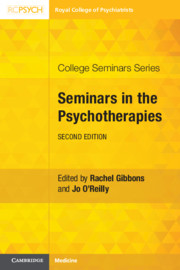Book contents
- Seminars in the Psychotherapies
- College Seminars Series
- Seminars in the Psychotherapies
- Copyright page
- Reviews
- Contents
- Contributors
- Foreword
- Preface
- Part I Therapy Theory and Practice
- Part II Applied Psychotherapeutic Thinking
- Section 1 Psychological and Psychodynamic Approaches to Psychiatry
- Chapter 13 Psychological Approaches to Affective Disorders
- Chapter 14 Psychological Approaches to Psychosis
- Chapter 15 Personality Disorder
- Chapter 16 Complex Post-traumatic Stress Disorder
- Chapter 17 Psychological Approaches to Medically Unexplained Symptoms
- Chapter 18 The Psychodynamics of Self-Harm
- Chapter 19 Psychodynamic Aspects of Suicide and Homicide
- Chapter 20 Forensic Psychotherapy
- Section 2 Work in Practice
- Section 3 Contemporary Developments
- Index
- References
Chapter 16 - Complex Post-traumatic Stress Disorder
from Section 1 - Psychological and Psychodynamic Approaches to Psychiatry
Published online by Cambridge University Press: 27 May 2021
- Seminars in the Psychotherapies
- College Seminars Series
- Seminars in the Psychotherapies
- Copyright page
- Reviews
- Contents
- Contributors
- Foreword
- Preface
- Part I Therapy Theory and Practice
- Part II Applied Psychotherapeutic Thinking
- Section 1 Psychological and Psychodynamic Approaches to Psychiatry
- Chapter 13 Psychological Approaches to Affective Disorders
- Chapter 14 Psychological Approaches to Psychosis
- Chapter 15 Personality Disorder
- Chapter 16 Complex Post-traumatic Stress Disorder
- Chapter 17 Psychological Approaches to Medically Unexplained Symptoms
- Chapter 18 The Psychodynamics of Self-Harm
- Chapter 19 Psychodynamic Aspects of Suicide and Homicide
- Chapter 20 Forensic Psychotherapy
- Section 2 Work in Practice
- Section 3 Contemporary Developments
- Index
- References
Summary
In this chapter, the focus will be on the newly emerging diagnosis of Complex Post-traumatic Stress Disorder (C-PTSD). Following a brief overview of the history of the concept and some diagnostic issues that arise, a description will be given of common symptoms and presentations in C-PTSD. A case history will be used to illustrate these points. The chapter ends with a brief outline of some of the principles of treatment.
- Type
- Chapter
- Information
- Seminars in the Psychotherapies , pp. 207 - 220Publisher: Cambridge University PressPrint publication year: 2021



